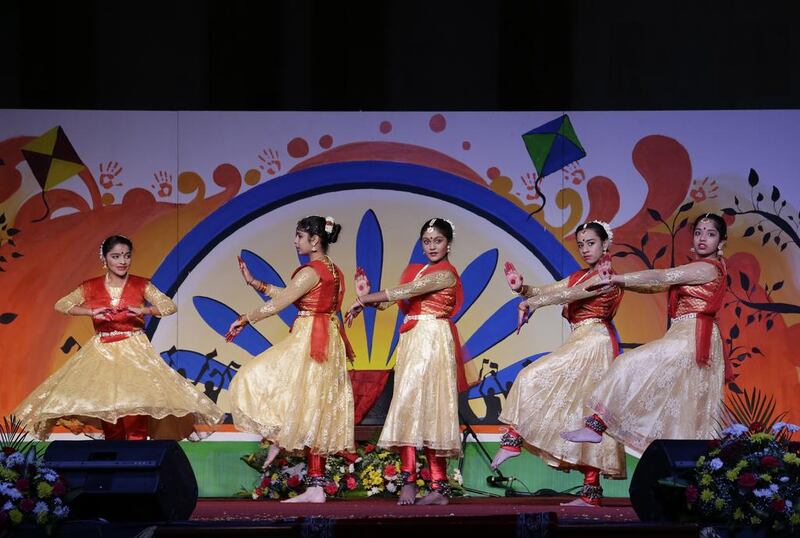“The way we do it is different from bharatanatyam,” says Ketki Hazra, 60, as she describes the delicate gesture for a flute with her hands.
The dance form Hazra has taught and championed for more than 30 years in the UAE is kathak, a classical Indian dance that originated in the north and is said to have evolved from a tradition of storytelling that involves dance, mime and music.
Although classically-trained, Hazra is always looking to incorporate other musical and dance forms, such as folk, into performances and is keen on women’s themes and narratives.
For a recital in October as part of Nrityanjali, an annual non-profit event she has organised since 1985, Hazra turned to Bharat's Natya Shastra, a classical text written before 200AD for Ashta Nayika – or eight types of heroines – which captures the emotions of a woman in a relationship.
Even though couples might now communicate through Facebook or WhatsApp, what they say has not changed, says Hazra. “The fights, the making up, dressing up for dates and missing someone, is all as true today as it was then.” The choreographer incorporated two of Rabindranath Tagore’s dance-dramas to illustrate stree shakti, or women’s power, in a performance on behalf of the Indian consulate in December.
In the first dance-drama, Chandalika, Prakriti, an untouchable, learns to see herself as a human being after a monk insists on drinking water drawn by her.
The warrior princess protagonist in Chitrangada is rejected by her chosen prince because, although able and brave, she is not conventionally beautiful. So she turns herself into a delicate beauty to win his heart but cannot keep the truth from him and reveals her true self, as she wants him to love her for who she is.
“What has inspired me from childhood is this idea that Chitrangada is a princess and she says: ‘I’m not a goddess, nor everywoman. I do not want that you worship like one, or set me aside like another. If you treat like an equal, in our happiness and in my time of need or in yours, you will know who I am’,” says Hazra. On her arrival in Dubai in 1984, she says kathak was relatively unheard of. “People generally thought it was a Bollywood dance and not classical.”
When the Indian community learnt she had trained in the classical dance forms of bharatanatyam, kathak and manipuri in Kolkata, she was asked to teach.
“Kids these days are very sharp,” says Hazra in her lyrical voice. “They start at four years now. When I first began, I taught students aged six and above.”
She has a few ideas that she wants to work on. “I don’t dance anymore myself, but I can guide them with a glance here, or an expression or gesture there. And they quickly get what I want.”
Hazra taught dance for 10 years at the Modern High School, Dubai. After her husband died in 2000 she considered returning to India. But her students kept her going. “My students gathered around me and said: ‘Auntie, you sit. We will dance.’ They came regularly and helped me overcome my loss. I’ll never forget this.”
Hazra is at the centre of a close-knit community. As we sit in her living room in Karama, students walk in, touch her feet and take their place on the carpet.
“I’ve been coming here since I was six years old,” says Akshita, 12. A pupil at Emirates International School, she says: “The dance helps you in life with qualities such as discipline.”
“It gives you confidence to be on stage, to face an audience,” says Mahika, 13, a pupil of Hazra’s for a similar length of time.
The students not only converge around a common interest in this room but have formed an alternative family and have maintained a strong connection with their homeland, often expressed through culture and politics.
“Every time something related to women happens – either here or in India, positive or negative – Ma’am has something to say,” says Manju. “She has always wanted to do something on women, and has a clear idea of what she wants to present. How it was in the old days, the role a woman has in a man’s life and in society, and how this has not changed.”
“Even though we are in 2016, there are many incidents and practices that suggest that women are not equal to men. It might be the pay a woman receives, or the career that a woman decides on,” says Anadika, 21, an avionics engineering student who has trained with Hazra for 15 years. “These are things we have discussed in our dance classes as well.”
“Hazra auntie is like a mother to me, she is a huge inspiration. Being a woman, of such an age, and despite all the struggles, she has run the academy for more than 30 years and puts on a performance every year. That’s not an easy task.”
Azar Zaidi is a production journalist at The National.










